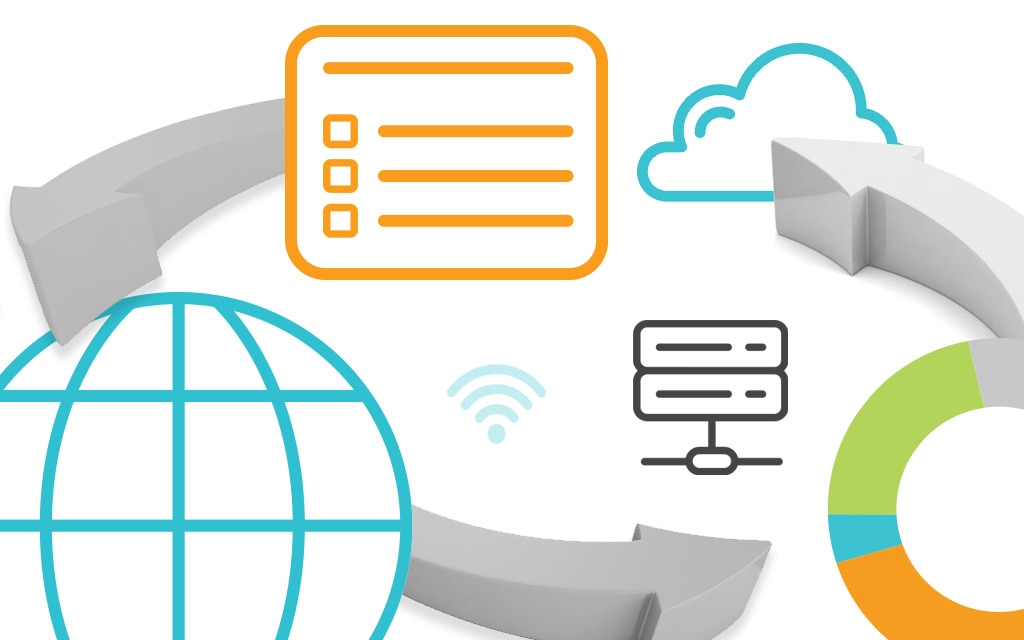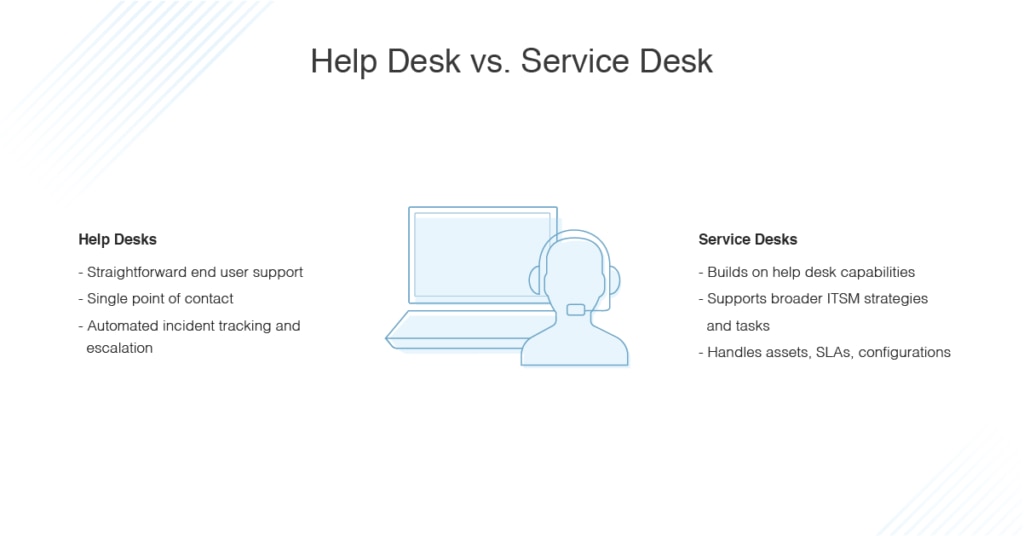When companies talk about their IT services, they may be referring to a help desk, a service desk, or something else altogether. Part of the problem is the differences between a help desk and a service desk aren’t always clear. Since the distinction can make a difference, especially when choosing a software solution, this guide offers a comparison between them.
 © 2022 SolarWinds Worldwide, LLC. All rights reserved.
© 2022 SolarWinds Worldwide, LLC. All rights reserved.
What Is a Help Desk?
What Is a Service Desk?
Understanding a Help Desk vs. a Service Desk
Does the Difference Between a Help Desk and a Service Desk Matter?
Which Tool Do You Need?
Company Size
Must-Haves
Focus on Usability
Vendor Support
Choose the Right Approach
Get Started with a Tool
What Is a Help Desk?
One of the distinguishing features of an IT help desk is it’s tactical and reactive. Help desks are designed to resolve IT-related issues for end users, such as configuring a new laptop or resetting a password.
A help desk software provides organizations with a way to track reported issues and follow them through to completion. Key features include the following:
- Acting as a single point of contact (SPOC)
- Tracking incidents in a software solution and following them through to resolution
- Providing automation for issue tracking, escalation, and notifications
- Supporting service requests and service level agreements (SLAs)
- Offering limited integration with IT service management (ITSM) practices
Help desks are effective in managing basic IT requests. They’re often viewed as a “break/fix” solution focused on getting the end user up and running as quickly as possible.
What Is a Service Desk?
A service desk is a more encompassing and strategic approach to IT. The service desk evolved from the help desk as a part of ITSM best practices, with the goal of treating IT as a service.
IT service desks need to consider more than individual users. They focus instead on the overall business needs and desired goals. Key features of a service desk include the following:
- Integrating fully with ITSM processes in service strategy, service design, service transition, service operation, and continual service improvement
- Service management automating solutions to prevent problems from reoccurring
- Maintaining a knowledge base for future reference
- Ensuring compliance with SLAs
- Providing a SPOC for all IT-related areas and processes
- Recommending updates proactively to services, processes, and equipment to improve IT practices
While a service desk may include a help desk, it goes beyond a help desk by focusing on support for the overall business.
 © 2022 SolarWinds Worldwide, LLC. All rights reserved.
© 2022 SolarWinds Worldwide, LLC. All rights reserved.
Understanding a Help Desk vs. a Service Desk
When IT was first evolving in the 1980s, the goal of IT teams was to troubleshoot IT issues and provide fixes. Help desks focused on helping IT teams achieve this goal; at the time, users’ needs and priorities weren’t given sufficient consideration. Help desks have changed over the years, but their underlying goal is still to improve the work of IT teams.
Service desks, on the other hand, have always focused on user needs. Their intent is to provide excellent overall service instead of only fixing immediate problems. A good service desk factors in business needs and defines a time frame for when service should be completed. These timelines are also known as service level agreements (SLAs).
On the most basic level, their names describe the difference. A help desk provides immediate help for an end user, and a service desk provides overall IT service for the company. A help desk is designed to fix immediate problems (also known as incident management), whereas a service desk addresses those break/fix issues as well as requests for service (for example, upgrading the company to a new software version) and informational questions (for example, “Where can I find X information?”).
Overall, help desks are typically tactical, focusing on short-term needs and goals. A service desk must consider the best overall strategy to support the business goals. The service desk encompasses all the services offered by IT, and a help desk covers a smaller subset of the company’s IT needs.
Does the Difference Between a Service Desk and a Help Desk Matter?
IT professionals have different opinions on the need to distinguish between a help desk and service desk, but it can be an important distinction.
Help desks are reactive and focus on short-term concerns. The break/fix approach makes them task oriented, with cases resolved one at a time as they come. In a way, a help desk is like an urgent care center; it focuses on individual end users and specific problems as they arise. Help desks don’t need as many options in a software solution and can often be run with fewer resources.
Service desks, on the other hand, allow you to take a step back from the immediate issues to consider what would help the company in the long run. The goal of a service desk is to be proactive, finding ways to support business goals before issues come up with the current approach. This is a more holistic view intended to consider all areas of the company and how they can best be supported.
Additionally, service desk software is more robust. It often includes help desk functionality but automates everything possible to allow more time for strategy. This includes having more analytics to review processes and identify areas of improvement. The added complexity means a service desk also needs more resources to be effective.
From this perspective, if you talk about a help desk when you mean a service desk, you won’t be giving enough credit to your IT team or the software you use. Similarly, if you mention a service desk but have a help desk instead, you may give the impression your IT team has a broader focus than they do.
Which Tool Do You Need?
All companies need IT support, but not everyone needs a service desk. When deciding which is more appropriate for you, you’ll want to consider what requirements you have for a software tool. Here are some best practices for choosing help desk vs. service desk approaches and tools.
Company Size
Think about the size of your company. If you have a smaller business, a service desk may be more than you need. If you choose this option, you’ll end up paying for software and resources that aren’t necessary. If you have a larger company, though, a help desk likely won’t be enough. You’ll want to have a more strategic approach with a service desk.
Must-Haves
With many solutions on the market, it can be easy to get caught up in all the functionality add-ons and think you need to have every one of them. As attractive as those options are, you should take a step back and ask the following questions:
- What are your fundamental requirements?
- Will the additional features be useful, or will they make the solution more complicated for the users?
You can then decide how much functionality you need. You can also consider starting with a smaller solution and upgrading as your company grows. A help desk might be a good place to start; as you evolve, you can move to a service desk approach.
Focus on Usability
Your IT team will use the tool you choose every day, so you want to make sure it’s a program without a steep learning curve. If the software is too complex, the team may get overwhelmed and may not use it as effectively as possible.
Vendor Support
The software tool itself is important, but the vendor is too. Make sure you’ll have good support and that the vendor will provide regular updates to address evolving business needs and regulatory requirements.
Get started with a Tool
SolarWinds® Web Help Desk is an excellent choice. This will cover your needs for ticketing, asset management, knowledge management, and more. You can check out this tool during the free trial period.
On the other hand, if you’re looking for a solution to encompass those areas and provide a more strategic view, you should consider a service desk such as SolarWinds Service Desk. This is an all-around solution designed to provide automation, analytics, and full support for your ITSM processes. In this case, a free trial period is also available.


